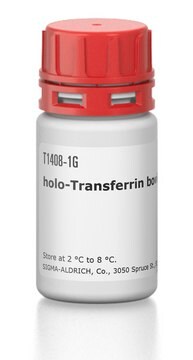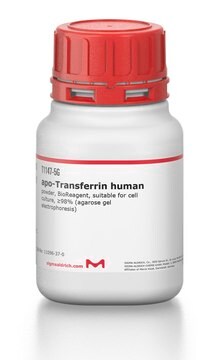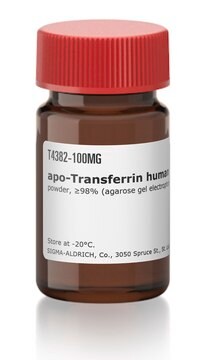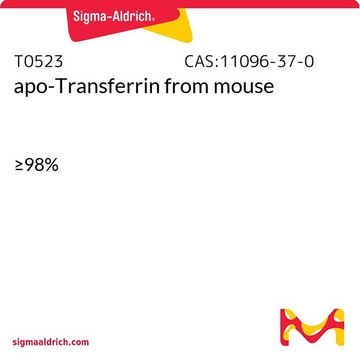T1283
holo-Transferrin bovine
Iron-saturated, BioReagent, suitable for cell culture
Synonim(y):
Siderophilin, Siderophilin, iron-saturated
About This Item
Polecane produkty
Poziom jakości
linia produktu
BioReagent
Próba
97-100% (agarose gel electrophoresis)
Formularz
powder
stężenie
~25 mM
metody
cell culture | mammalian: suitable
zanieczyszczenia
endotoxin, tested
rozpuszczalność
H2O: 50 mg/mL
numer dostępu UniProt
Warunki transportu
ambient
temp. przechowywania
2-8°C
informacje o genach
bovine ... TF(280705)
Szukasz podobnych produktów? Odwiedź Przewodnik dotyczący porównywania produktów
Zastosowanie
Komentarz do analizy
Kod klasy składowania
11 - Combustible Solids
Klasa zagrożenia wodnego (WGK)
WGK 3
Temperatura zapłonu (°F)
Not applicable
Temperatura zapłonu (°C)
Not applicable
Środki ochrony indywidualnej
Eyeshields, Gloves, type N95 (US)
Wybierz jedną z najnowszych wersji:
Masz już ten produkt?
Dokumenty związane z niedawno zakupionymi produktami zostały zamieszczone w Bibliotece dokumentów.
Klienci oglądali również te produkty
Produkty
How transferrin and other cell culture components affect the performance of serum-free, protein-free cell culture systems used for biomanufacturing heterologous proteins including monoclonal antibodies. The page introduces the in vitro chemistry and biochemistry of transferrin.
Nasz zespół naukowców ma doświadczenie we wszystkich obszarach badań, w tym w naukach przyrodniczych, materiałoznawstwie, syntezie chemicznej, chromatografii, analityce i wielu innych dziedzinach.
Skontaktuj się z zespołem ds. pomocy technicznej











